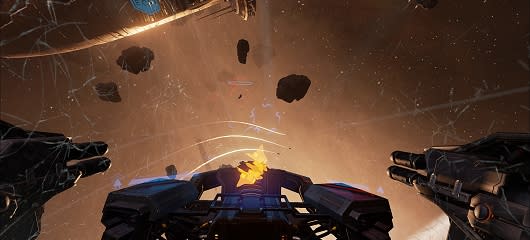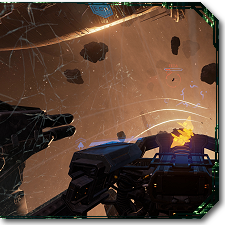Massively's hands-on with EVE Valkyrie on the Oculus Rift DK2
At last year's EVE Fanfest, the press and attendees got a rare glimpse into something other than CCP's major IPs -- a virtual reality tech demo produced by a handful of developers during their down time. Originally codenamed EVR, this VR dogfighter on the original Oculus Rift development kit drew a surprising amount of attention and went on to win several awards at E3. It's now been a year since that project first sprouted legs, and last week at EVE Fanfest 2014 it sprouted wings as well.
Now named EVE Valkyrie, what started as a side-project has become one of CCP's key intellectual properties and the poster-child for virtual reality gaming. The game's success now ultimately relies on the adoption of VR tech and the appeal of its gameplay, both of which are still open questions at this point. I got some hands-on time with the latest build of Valkyrie during Fanfest to see how the game and the technology that powers it have come along in the past year, and I was pleasantly surprised.
Read on to find out how Valkyrie has changed in the past year and for a first look at the new Oculus Rift Development Kit 2.
Gameplay and the Battlestar Galactica vibe
The announcement that Battlestar Galactica's Katee Sackhoff will be playing the voice of Valkyrie's main character has really put the game on people's radars and made it a solid contender in the emerging space dogfighter scene. The strong BSG influence in Valkyrie is evident even in gameplay, with the player being fired out of a Viper-like launch tube toward a wave of enemy fighters. The game even takes place on a carrier with a jump drive, and Katee Sackhoff talks to you over the radio. Unless an official Battlestar Galactica game is released, Valkyrie is as close as you'll ever get to being a Viper pilot.
The game feels a lot more solid and polished than it did last year, and the graphics have improved markedly. Direct-fire machine guns are still quite difficult to aim, but getting a kill with them is much more satisfying and visceral than I remember. The auto-tracking missiles that lock onto targets using head tracking feel a lot more balanced as each missile now locks on individually and fighters have missile-scrambling countermeasures. The controls also felt a lot more responsive and I was eventually able to pull off some tricky maneuvers, spinning 180 degrees to catch pursuing fighters or slamming on the brakes to let them pass.
Is Valkyrie a MOBA?
The main things that would have made the demo better are all co-operative in nature: voice chat, mission objectives, teamwork-oriented gameplay, and more tactical options. Thankfully, that's exactly the angle CCP is taking in development! I'm told that the final game will contain tactical environments like debris fields and dust clouds with different effects, and some missions will even send you inside structures. The flight and combat in Valkyrie are fun, and I get the feeling that the game will really come together once it has more in-depth mission objectives and co-operative gameplay.
Valkyrie's developers admitted that they're drawing a lot of influence from MOBAs, with more team-based gameplay planned and even support and tank roles. We don't yet know whether the game will have other MOBA features such as NPC creeps, skill progression within each match, destructible control towers, or capturable objectives, but I wouldn't be surprised to see all of that. Valkyrie seems uniquely positioned to capitalise on the largely untapped space MOBA genre and set itself firmly apart from the upcoming crop of space dogfighters.
The Oculus Rift Development Kit 2
One of the most common comments after the first EVR demo last year was that some people might feel motion-sick after about 15 minutes. I'm not prone to motion-sickness and I too felt the confused signals generated by turning my head while my ship flew off in another direction. Oculus VR has been battling this problem ever since, and it looks like their hard work has paid off. This year's Valkyrie demo took place on the second generation Oculus Rift devkit, and was augmented by a new piece of kit we hadn't seen before.
Sitting atop ominous-looking metal poles were new external positional sensors, which we were told were some of only 17 such sensors in the world built so far. I don't know if it was this new sensor alone or its combination with the second generation dev kit, but I didn't get a hint of any disorientation or motion sickness. Individual pixels could still be made out in dark scenes and there was blurring outside the central field of view, but the quality of experience on the DK2 was impressive. The resolution was a lot higher than the original devkit and there wasn't any discernible motion blur.
If last year's EVR demo was a proof-of-concept for a VR dogfighter, then this year's Valkyrie hands-on was a successful proof-of-product. Valkyrie feels like a solid mix of the dogfighting gameplay of Elite: Dangerous or Star Citizen but in a shorter MOBA-style format, a combination that could be fantastic. The game now has a full development studio working on it at CCP's Newscastle office under ex-DICE Executive Producer Owen O'Brien, and plans for the future look good. If all goes well, Valkyrie could be the immersive fighter experience a lot of would-be EVE players have been waiting for.

Whether you're a die-hard fan of internet spaceships or just a gawker on the sidelines, EVE Fanfest is the EVE Online event of the year (and the key source of new DUST 514 and EVE Valkyrie scoops!). Follow Massively's Brendan Drain as he reports back on this year's Fanfest starpower, scheming, and spoilers from exotic Reykjavik, Iceland.






